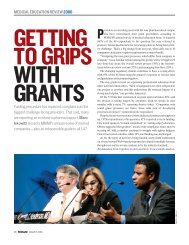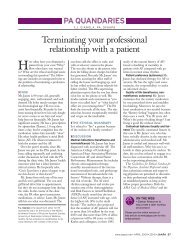Fournier's gangrene: Be alert for this medical emergency
Fournier's gangrene: Be alert for this medical emergency
Fournier's gangrene: Be alert for this medical emergency
You also want an ePaper? Increase the reach of your titles
YUMPU automatically turns print PDFs into web optimized ePapers that Google loves.
with radiation treatment <strong>for</strong> proctitis, spinal cord injury, and<br />
femoral heroin injection. 12<br />
The necrotizing process commonly originates with an<br />
infection in the anorectum, the urogenital tract, or the skin<br />
around the perineum. 13 Anorectal causes include an infection<br />
in the perianal glands, colonic diverticulitis, decubitus ulcers,<br />
or a colorectal injury or malignancy. Urogenital etiologies<br />
include an infection in the bulbourethral glands, a urethral<br />
injury, a lower urinary tract infection, or an iatrogenic injury<br />
secondary to stricture manipulation. Dermatologic causes<br />
include hidradenitis suppurativa, scrotal pressure ulceration,<br />
trauma, a surgical complication, or intentional trauma such<br />
as skin-popping—a <strong>for</strong>m of injection drug abuse. Other diseases<br />
in addition to diabetes that increase the risk of developing<br />
Fournier’s <strong>gangrene</strong> are systemic lupus erythematosus,<br />
Crohn’s disease, and HIV infection. A less commonly<br />
reported cause is bone marrow malignancy. 14,15<br />
Fournier’s <strong>gangrene</strong>, like most cases of necrotizing infection,<br />
has a multiorganism nature; 16 the disease is due to polymicrobial<br />
infection with a mixture of aerobic and anaerobic organisms.<br />
17 The majority of cases are caused by normal flora of<br />
the lower GI tract, 18 most commonly Escherichia coli. 19 Other<br />
causative micro-organisms include Staphylococcus, Streptococcus,<br />
and Enterobacteriaceae species, anaerobic organisms, and fungi.<br />
The infection is rarely caused by one organism; as many<br />
as five species may be cultured.<br />
The hallmark of Fournier’s <strong>gangrene</strong> is intense pain and<br />
tenderness in the genitalia. The clinical course progresses<br />
through several phases. First, fever and lethargy develop.<br />
Next, patients experience intense genital pain and tenderness<br />
associated with edema of the overlying skin, which appears<br />
dusky, indicating subcutaneous crepitance. Soft tissue gas, a<br />
byproduct of anaerobic metabolism, is produced. 20 As genital<br />
pain and tenderness increase, obvious <strong>gangrene</strong> in a portion<br />
of the genitalia and purulent drainage materialize (see Figure<br />
1). Systemic effects range from local tenderness to septic<br />
shock, depending on necrotic progression.<br />
MAKING THE DIAGNOSIS<br />
Fournier’s <strong>gangrene</strong> is diagnosed primarily on clinical<br />
grounds, as diagnostic studies risk postponing treatment. In<br />
cases of rapid accessibility, uncertain diagnosis, or suspicion<br />
KEY POINTS<br />
■ Fournier’s <strong>gangrene</strong> was originally thought to be an idiopathic <strong>gangrene</strong> of the genitalia;<br />
however, a specific etiology is found in approximately 95% of cases. Anorectal abscesses,<br />
genitourinary infections, and traumatic injuries are the most common causes.<br />
■ Typically, fluctuance, soft-tissue crepitance, localized tenderness, or occult wounds in the<br />
genitalia, perineum, and anorectal area should <strong>alert</strong> the examiner to the possibility of<br />
Fournier’s <strong>gangrene</strong>. A CBC, comprehensive metabolic panel, coagulation profile, and blood<br />
cultures should be obtained.<br />
■ Once the diagnosis is established, emergent surgical excision of all necrotic tissue must be<br />
per<strong>for</strong>med. Given the potential fulminant nature of <strong>this</strong> necrotizing process, repeat debridement<br />
procedures are usually needed to completely eradicate the infection.<br />
FIGURE 2. CT shows small pockets of gas in the rectum (arrows).<br />
FIGURE 3. Fluid collections along the deep fascial planes (arrows)<br />
are demonstrated on CT.<br />
of retroperitoneal or intra-abdominal sources of infection,<br />
imaging studies should be considered. 21 Careful palpation of<br />
the genitalia and perineum and a digital rectal examination<br />
are important parts of the physical examination. Table 3<br />
(page 46) lists the signs and symptoms of Fournier’s <strong>gangrene</strong>.<br />
Typically, fluctuance, soft-tissue crepitance, localized<br />
tenderness, or occult wounds should <strong>alert</strong> the examiner to<br />
the possibility of Fournier’s <strong>gangrene</strong>. A CBC, comprehensive<br />
metabolic panel, coagulation profile, and blood cultures<br />
should be obtained.<br />
Continued on page 46<br />
COMPETENCIES<br />
●●●●● Medical knowledge<br />
● Interpersonal & communication skills<br />
●●● Patient care<br />
● Professionalism<br />
● Practice-based learning and improvement<br />
● Systems-based practice<br />
NOVEMBER 2007 • 20(11) • www.jaapa.com • JAAPA 45

















